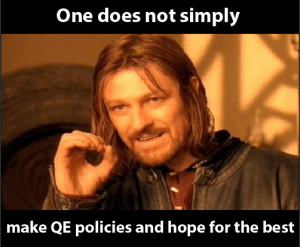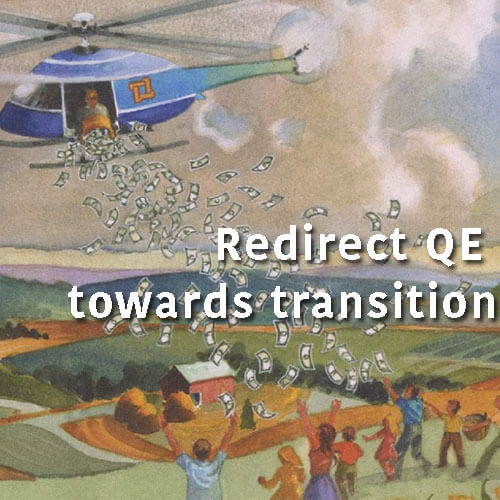[This call was originally published in french. Please excuse any typographical errors]
Mario Draghi brought out the big guns on Thursday the 10th of March by expanding the QE policy of the ECB (for example, the main refinancing rate is cut to zero, the amount of bonds central bankers buy each month under QE is increased by 20 billion euro, and new liquidity is provided to banks if they increase credit, etc.) This demonstrates an understandable fear of deflation which seems to be settling in. The financial markets do not seem convinced – neither are we.
ECB’s QE is not working and is harmful. We have explained why this is so earlier on this blog (fr). We deplore this all the more so as for our Central Bankers this QE policy is an unconventional idea, a “one last chance”, aimed at 1) avoiding the liquidity trap in which Europe is being swamped at a fast pace, 2) at reviving the real economy (employment above all), 3) at justifying the power of European institutions whose legitimacy verges on the absolute zero… In short, this QE is aimed at saving Europe from its economic and sovereign crises.
Economic dogmatism and monetary policy
This QE does not work because it is based on several false assumptions, derived from dogmas that our French and European economists are so fond of:
- They believe that increasing a bank’s liquidity automatically increases the level of credit to the real economy, without taking into account the depressing context that all-round austerity has plunged European businesses into. You can lead a horse to water but you can’t make it drink…

The Boromir meme : One does not simply walk into Mordor - They believe that a country’s economy can be boosted only by a zero budget deficit, and so they impose austerity on all members of the European Union, in particular a GDP budget deficit target of 3% which has come out of thin air – which non-elected technocrats enforce with the threat of default via the budgetary stability pact.
- They believe that it is desirable and feasible to achieve the same kind of GDP growth that prevailed during “The Glorious Thirty” (1945 to 1975 in post WWII France). They refuse to understand that this kind of growth involves dramatically diverse social and economic realities, and in itself destroys the basis of the economy, i.e. energy and resources.
- Even more amusing, they believe that financial crises do not exist (see Gael Giraud’s analysis of macro-economy here and here (fr)), thereby they play with fire by adding to the existing capacity of banks to speculate daily on the financial markets, which have been transformed into perpetual casinos (BNP Paribas alone is dealing with 48,000 billion euros in derivative products at notional value). This creates all-round bubbles and booms in a fragile context where “sunspots” can quickly drive finance as a whole into the ground, with no shelter for the tax payer – in fact quite the contrary.
For a monetary financing of the transition to a green economy
Not only is it highly questionable that the objectives of the ECB (ratcheting up credit, triggering a 2% inflation, etc.) deserve this heavy weaponry and the risks associated with it but also it is precisely on these criteria that the QE policy of the ECB is a total failure. It is therefore urgent that this harmful and useless machinery that we will call here “conventional QE” be stopped, even if it did save the euro during the 2008 global financial crisis. It is equally urgent to emerge from the dogmatic rut into which we are pushed against our will, and to launch monetary policies that are realistic and, above all, effective.
We believe :
- That monetary policies should primarily serve such objectives as employment and the transition towards a more sustainable economy, and not primarily as a tool to fight inflation.
- That non-conventional monetary policies should not feed bubbles on the financial markets, when they carry major inherent risks of destabilizing the economy.
- That what must be tackled is the regulation of the banking system, in particular by separating the retail and investment banking arms of global banks, and by fighting effectively against tax havens.
- That the 3% Maastricht budget deficit target is nonsense in a deflationary context, where money is overflowing but projects cannot be financed; public sector projects are hindered by the 3% deficit limit and private sector projects are hit by the deflationary prospects.
- That financing economic growth and consumption as done before in the past is counterproductive in the context of the current Anthropocene: it deepens our dependency on fossil fuels and their exporters as well as our ecological footprint in a world where the fish in the sea, arable land, rare metals, potable water, clean air, and habitable land (as climate refugees make us aware of) are all becoming scarce.
- That it is urgent to plan and finance the ecological transition at scale by targeting the current QE not towards banks and financial markets but towards green project proposals from both the public and the private sector. This should be achieved without accounting for the corresponding expenses in the “standard budget deficit”, but rather by explicitly insolating them, getting them away from the Maatstricht straitjacket, and by controlling them with intelligent rules.
Such a green QE would allow for: a local employment stimulus shock; a stimulus of the green business; a sharp decrease in systemic financial risks; a return to a limited level of inflation which can be put under control with conventional monetary policies (no risk of barrowfulls of banknotes of the Weimar Republic/Zimbabwe kind) and a re-legitimation of the european political project by using its governance tools for creative uses, with no neo-liberal bias.
Creating thousands of billions of euros to finance the transition towards a green economy: a Green QE such as this is achievable technically, legally and politically. We have been advocating it for years, notably with the Nicolas Hulot Foundation (FNH): see the 2011 campaign “Funding the future without deepening the debt” and also the book C’est maintenant (Jean-Marc Jancovici and Alain Grandjean, 2009).
The various alternative QEs and the QE4people campaign
We are not alone in this line of thinking. Many economists have put forward and have documented alternatives to the currently enforced QE policy.-
- The “Strategic QE” of the New Economics Foundation by Richard Werner aims at directly financing public sector investments such as health, education and green transition investments through QE.
- Green QE put forward by Victor Anderson and supported by several members of the European Parliament, proposes a financing plan for the green transition and a selection method for “green” investments
- The report “Recovery in the Eurozone” by Franck Van Lerven supports the « QE for People » campaign by allowing for the two previous possibilities while adding a third: the direct financing of household consumption through QE.
- The Juncker plan, inspired by the SFTE project (en) which came out of the campaign “Funding the future without deepening the debt” by the Nicolas Hulot Foundation, even if this plan lacks momentum.
- The French think tank France Stratégie promoted in 2015 an intiative for the monetary financing of low carbon investments in Europe, based on an initial idea by French economists Michel Aglietta and Jean-Charles Hourcade. This involves making low carbon investments eligible to ECB asset purchases.
- Several other proposals are documented and available under the “Publication” section of Positive Money, a think tank dedicated to sovereign monetary policies. Many web resources are available in French and English for a better understanding of these topics. For example in french: monnaie honnête, chômage et monnaie, financer l’avenir, Projet SFTE and their many “useful links”. For resources in english, see the Positive Money website.
The ongoing campaign “QE for People” by Positive Money is putting together the different proposals listed above, with the aim of drawing the attention of citizens, politicians and ECB governors on these matters.
With the support of three Members of the European Parliament (MEPs), Molly Scott Cato, Fabio De Masi and Paul Tang, the campaign stirred a passionate debate at the Parliament in Brussels on the 17th of February 2016, which can be viewed at https://www.youtube.com/watch?v=LU4V8G0G_Tc
Chronicles of the Anthropocene is joining this initiative, along with the French think tanks Collectif Roosevelt, Mouvement Sol, Jean Gadrey and seventy-five other economists, all of whom have signed the Positive Money petition “Recovery in the Eurozone” (mentioned above). In this way, Chronicles of the Anthropocene commits to participating in, documenting and promoting a Green QE as an urgent substitute for the current and conventional ECB QE.
We are launching a working group to consolidate our ideas of Green QE and we invite all interested parties who would like to to join the project to get in touch with us here.
Members of the European Parliament can regain control of monetary policy. To that effect, action and support by public opinion and actors in the civil society is necessary.
The Chronicles of the Anthropocene Team[1]
- Sign the Positive Money petition
- Join the Green QE movement (fr)
- Lobby your MPs (UK)(en)
- Get familiar with the international movement for monetary reform
[1] Alain Grandjean, Gaël Giraud, Pablo Grandjean, Mireille Martini


